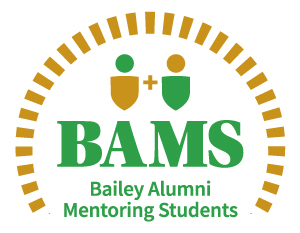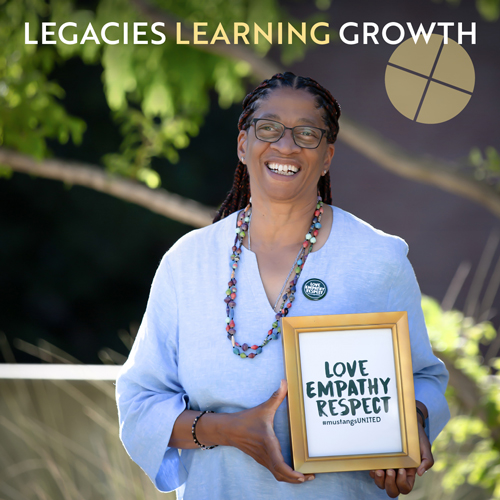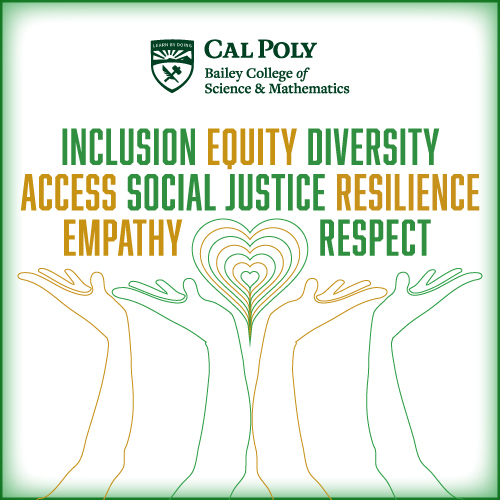Deep Learning in South Pacific Shallows
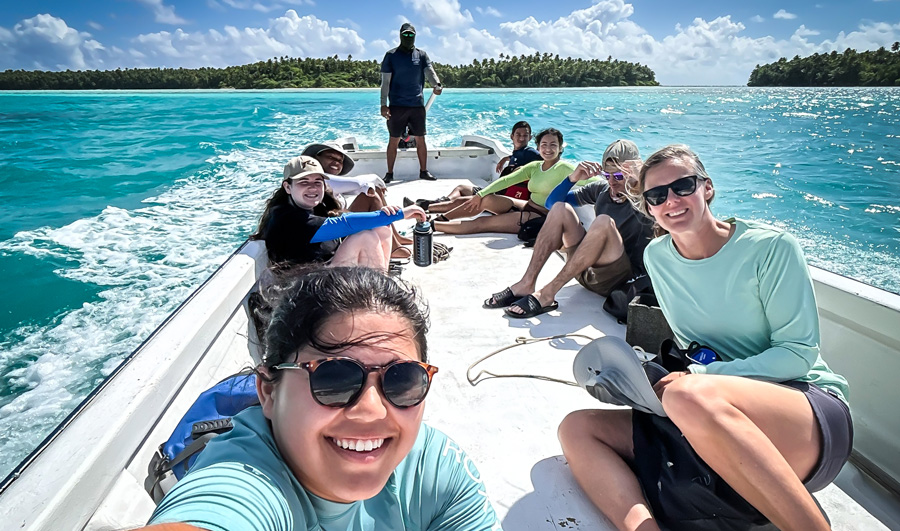 A Polynesian guide shuttles the research class back through the Tetiaroa lagoon after a day of work collecting seawater samples. From bottom-left clockwise are Emma Kurata, Kara Fitzsimmons, Sasha Evans, Tetiaroa Society Ranger Lusiano Kolokilagi, Ruben Moulton Huber, Mia Ramos, Cole Taylor and Professor Emily Bockmon. Photo by Emma Kurata
A Polynesian guide shuttles the research class back through the Tetiaroa lagoon after a day of work collecting seawater samples. From bottom-left clockwise are Emma Kurata, Kara Fitzsimmons, Sasha Evans, Tetiaroa Society Ranger Lusiano Kolokilagi, Ruben Moulton Huber, Mia Ramos, Cole Taylor and Professor Emily Bockmon. Photo by Emma Kurata
NEW BAILEY COLLEGE ABROAD PROGRAM OFFERS IMMERSIVE STUDIES AND CULTURAL EXPERIENCES IN FRENCH POLYNESIA
october 2025
by nick wilson
A summer education-abroad trip blended amazing cultural experiences and intensive oceanography research in a stunning setting — a remote island chain with see-through waters, gorgeous sunsets and abundant sea life.
A new education abroad program established by chemistry faculty Emily Bockmon and David Long took 16 dedicated student researchers to the South Pacific islands of French Polynesia in late June and early July.
They spent long days collecting samples, using technical instruments and assessing data while fitting in excursions, like hikes and snorkeling in mesmerizing settings, around their busy research schedules.
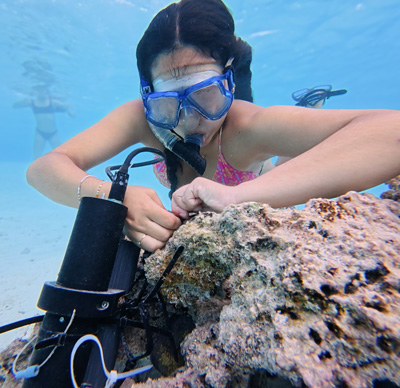
Chemistry student Mia Ramos snorkeling to secure an autonomous
pH logging instrument underwater. Photo by David Long
“French Polynesia is one of the most beautiful places that I have ever visited,” said Emma Kurata, a biochemistry major and a Frost Research Scholar. “The clear skies, blue waters, rocks and sand, peaceful, crisp air and starry nights were truly special. Everybody was working towards a common goal to learn more about these environments because we care about them.”
For Polynesians, the ocean has significant cultural meaning. And the students had special interactions with the islanders, who were curious about them and their work.
“Almost every local I interacted with was very kind, welcoming and understanding, and they wanted to get to know us,” Kurata said. “There, wealth is not based on what you have, but rather who you are, what you can give, and how you can help.”
After completing marine chemistry and lab courses at Cal Poly in spring quarter with Bockmon and Long, the group spent a week apiece on the island of Mo'orea and the atoll of Tetiaroa, part of the same archipelago as nearby Tahiti.
Mo’orea has a town community of over 18,000 people. And actor Marlon Brando, who once owned and lived on Tetiaroa, established a legacy of conservation and the atoll remains limited to research and eco-tourism, with few residents.
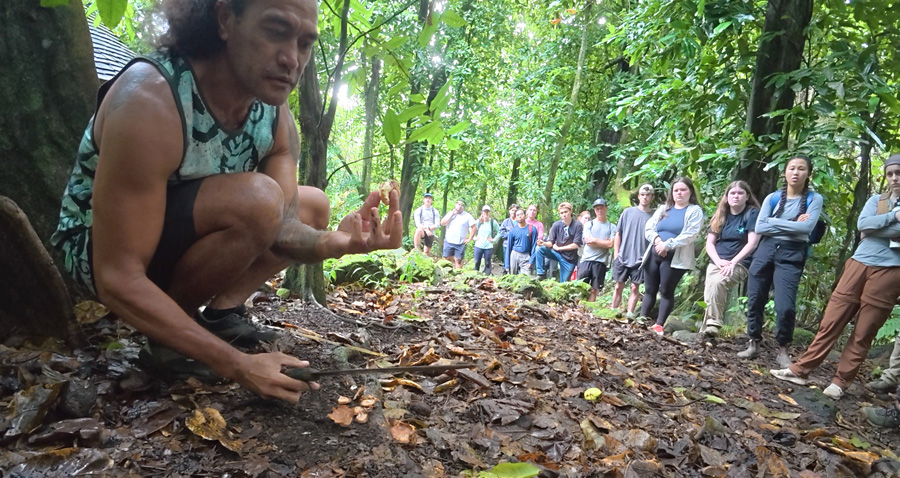 A local guide (left) teaches the research class about traditional Polynesian food preparation during a hike on the island of Mo’orea. Photo by David Long
A local guide (left) teaches the research class about traditional Polynesian food preparation during a hike on the island of Mo’orea. Photo by David Long
“French Polynesia is an ideal place for studying largely uninhabited, unspoiled environments that are very accessible,” Long said. “It’s a relatively safe environment for students who aren’t frequently in the ocean. Students did beautiful work, and some of the results are astounding.”
Student teams conducted studies related to various ocean conditions, including measuring carbon, nitrates and phosphates.
“It took a lot of coordination and teamwork,” said marine sciences major Maalav Panchal. “We had to build our projects from scratch, ask the professors a lot of questions, sample and test. In a sense, we were like master’s degree students.”
One study collected nutrient data revealing water quality was affected by bird droppings. Interestingly, bird populations have recovered after rats that once preyed on bird eggs were removed from multiple French Polynesian islands in recent years as part of conservation efforts.
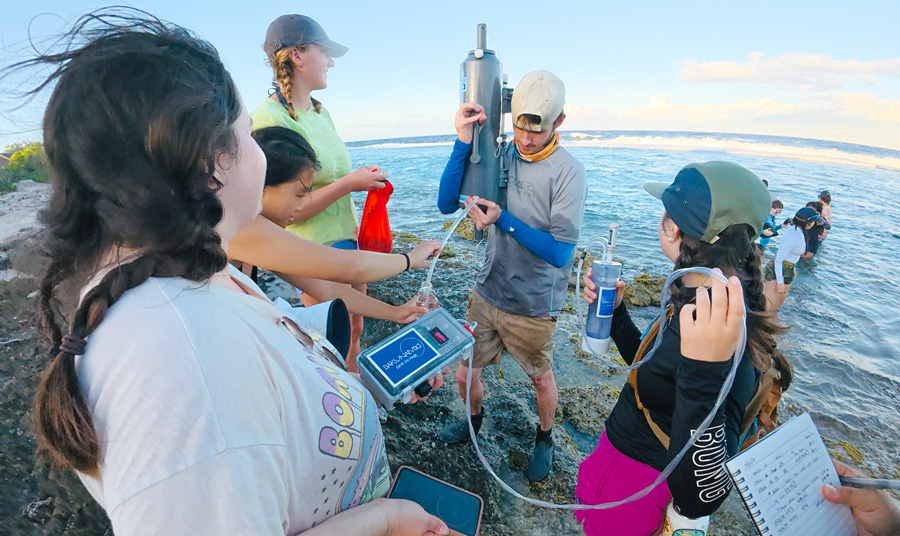 Students conduct ocean shore sampling off of Temae Beach on Mo’orea. From left: Avery Hoyt, Sasha Naughton, Emma Thorne, Cole Taylor and Skylar Collings. Photo by David Long
Students conduct ocean shore sampling off of Temae Beach on Mo’orea. From left: Avery Hoyt, Sasha Naughton, Emma Thorne, Cole Taylor and Skylar Collings. Photo by David Long
Separately, Kurata collaborated on a depth profile of a cherished lagoon on Tetiaroa, located in the center of the atoll, with fellow student researchers Sasha Evans and Kara Fitzsimmons. The data serves as a benchmark for helping to understand ecological conditions, including coral health.
“Their work resulted in nice, clear data using relatively affordable instruments from a 15-foot boat, right while in the middle of a lagoon,” Bockmon said.
Kurata said Polynesians consider the lagoon sacred and the physical spot where the underworld meets the human world.
“It was a truly special project with a shared curiosity of what this environment can hold and what that means for the world as we know it,” Kurata said.
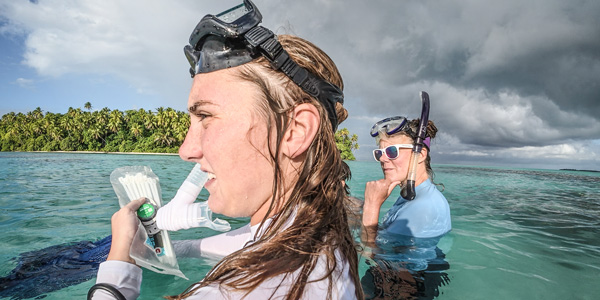
Cal Poly student Emma Thorne with biochemistry Professor Emily
Bockmon on the island of Tetiaroa, scouting for sampling locations.
Photo by David Long
The group also learned to adjust to surprises, including heavy currents and unexpected rains that increased freshwater runoff into the sea. Additionally, the researchers had to make on-the-fly adjustments to rewire a malfunctioning pH measuring device.
“They had to adapt to the environment and change their approach in response to changing conditions,” Bockmon said. “The students learned how to adjust and think through challenges. Those are essential research skills to develop.”
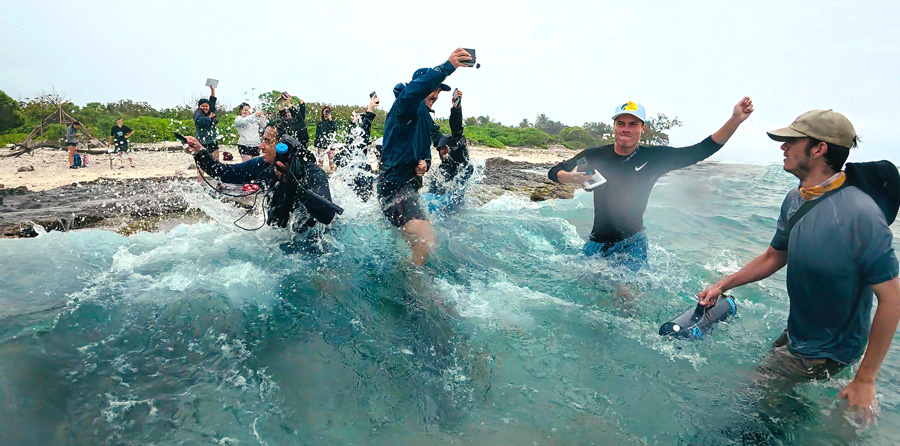 Students using analytical instrumentation in the surf, facing Learn by Doing challenges that ocean and marine chemistry field work can sometimes present. Photo by David Long
Students using analytical instrumentation in the surf, facing Learn by Doing challenges that ocean and marine chemistry field work can sometimes present. Photo by David Long
The faculty leaders said that the group worked well together, even collaborating with Polynesian park rangers. The data might help inform other scientific research and potentially serve as a baseline for future study.
The experience was funded by the participating students themselves, with limited scholarships available to support those in need. The faculty leaders are seeking donor support to ensure all students have access in the future.
In addition to long days of study and working out their experiments together, students will fondly recall the bonding experiences.
“I will remember the late-night conversations about life and our goals, the long nights in the lab working with rangers and guides in Tetiaroa,” Kurata said. “Despite not being able to anticipate some of the conditions, we were successful and accomplished meaningful goals.”
Kurata recalled a moment on Tetiaroa after they’d just finished decorating cards to give to locals expressing shared love for the ocean. The group sat in silence and watched the sunset as reef sharks swam in shallower waters, their black fin tips gliding with the current.
“It was a genuine people moment,” Kurata said. “It reminded me of why we were there — to study this environment but also embrace it and learn that in
a world where science is continuously devalued, people and places connect
us all, and that can sometimes be enough motivation to keep working.”
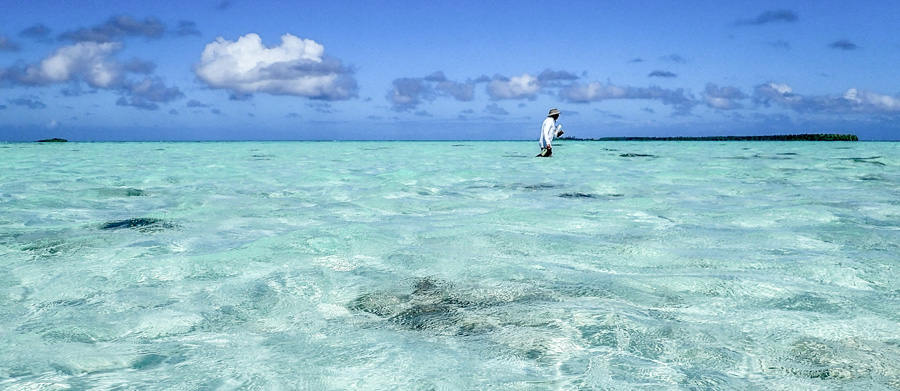 Chemistry faculty David Long scouting the Tetiaroa lagoon for locations to deploy instrumentation. Photo by Emily Bockmon
Chemistry faculty David Long scouting the Tetiaroa lagoon for locations to deploy instrumentation. Photo by Emily Bockmon
